 Asia-Pacific Artificial
Asia-Pacific ArtificialIntelligence Association
- Fellows
- AI Industries
- News
 Asia-Pacific Artificial
Asia-Pacific Artificial
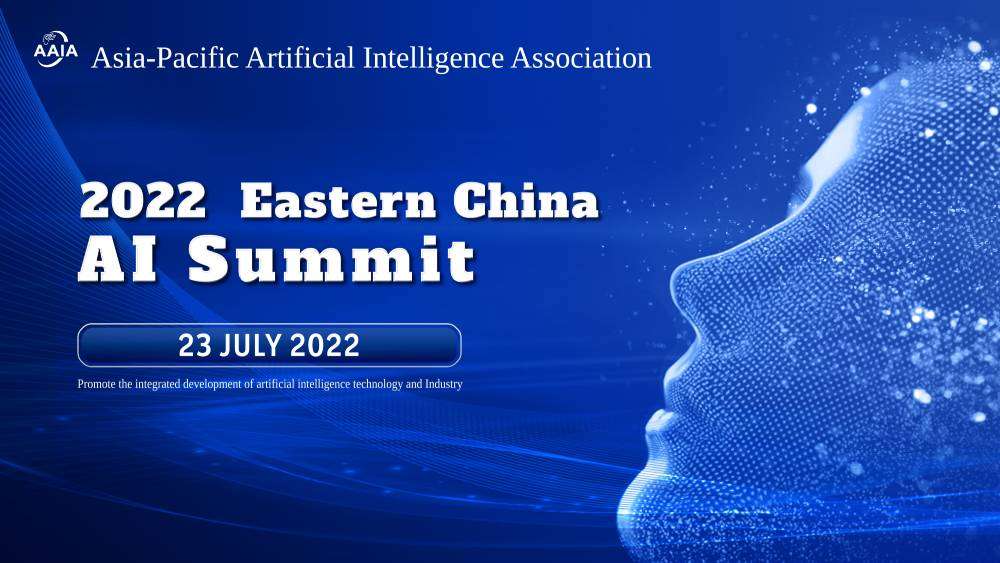
On July. 23th, 2022 at 19:30, Asia-Pacific Artificial Intelligence Association (AAIA) 2022 East China AI Summit was successfully held online.
This summit conducted in-depth exchanges and discussions on the development status of more than 10 cutting-edge technologies and industries, including big data, digital economy, analysis and intelligent control, machine learning, intelligent transportation, cross-modal learning, and emotional AI. The conference aimed to promote the popularization and promotion of artificial intelligence technology through the cross-integration of multiple disciplines, and to create a high-end frontier exchange platform that tightly integrates production, learning, and research in the field of artificial intelligence in China.
At this forum, the leading global experts in artificial intelligence gathered. More than 60 fellows of AAIA and more than 300 experts, scholars, and outstanding industry representatives shared the hot issues of common concern, such as cutting-edge technologies, industry status, application implementation, development trends and adjustments, etc.
Prof. Xuelong Li, (Vice Preaident of the AAIA, IEEE Fellow; ACM Fellow; AAAS Fellow; Member of Academia Europaea; Professor of Northwestern Polytechnical University) made an opening speech.
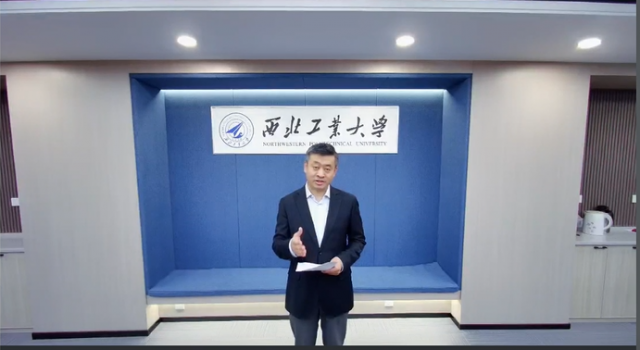
Prof. Li welcomed to all the experts and scholars attending the meeting and expressed his pleasure in participating in the east China forum. It is very meaningful to gather together artificial intelligence scientists to collect their wisdom, collide and communicate with each other, and explore how to combine AI-related studies with industry to promote the transformation and implementation of artificial intelligence technology. Prof. Li said that China had become one of the centers of global AI development, driven by several Chinese tech giants. A large population and a complete industrial structure provide China with the potential to create massive data and a vast market. As the region with the most active economic output in China, eastern China has attracted the attention of many world-class economic giants.
Subsequently, many experts and scholars brought outstanding thematic reports.
Prof. De-shuang Huang (IEEE Fellow; IAPR Fellow; Professor with the Department of Computer Science and Director of Institute of Machine Learning and Systems Biology at Tongji University, China) first gave a keynote report on “Thinking on the Development of Artificial Intelligence and Biomedical Big Data”.

Prof. Huang pointed out that the current wave of artificial intelligence is mainly driven by the representative of connectionism-neural network, and introduced the development process of artificial neural network. From single-layer linear perceptron to the shallow neural network, then to the deep neural network, the neural network has undergone several stages of development. Deep neural network mainly refers to the number of hidden layers of neural network. Currently, the number of layers of deep network can reach hundreds of thousands, and the amount of data that can be processed has reached millions. Due to the rapid development of the core module of neural network, artificial intelligence has the possibility of development.
Artificial intelligence also empowers life sciences and biomedicine research, such as deep learning and binding site prediction, biomedical big data research, etc.
These researches make drug development and target discovery more convenient. In addition, Prof. Huang extended his thoughts on life sciences and biomedical research, and mentioned three-dimensional genome and DNA binding site prediction research, various RNA data and disease association research, biomedical images and disease mechanism research, artificial intelligence, and biomedical and other aspects. Finally, Prof. Huang expounds on seven application scenarios of medical artificial intelligence: medical imaging, auxiliary diagnosis, disease prediction, drug research and development, health management, hospital management, medical research, etc.
Prof. Shihua Li (IEEE Fellow; IET Fellow; Recipient of the National Science Foundation for Distinguished Young Scholars; Vice Dean of School of Automation at Southeast University; Chief Professor and Director of the Mechatronic Systems Control Laboratory at Southeast University) conducted an in-depth analysis on “Modeling, Analysis and Intelligent Control of Electromechanical Systems”.
 Based on his long-term experience in electromechanical system control, Prof. Li pointed out all kinds of machines and equipment have higher requirements for intelligent information processing in a complex environment including multivariate information fusion, machine learning algorithms, making independent decisions, autonomous scheduling, and autonomous control, etc.
Based on his long-term experience in electromechanical system control, Prof. Li pointed out all kinds of machines and equipment have higher requirements for intelligent information processing in a complex environment including multivariate information fusion, machine learning algorithms, making independent decisions, autonomous scheduling, and autonomous control, etc.
The research orientation of Prof. Li is mainly in the combination of control theory and application, which is able to design improved control algorithms with advanced engineering realization based on analyzing the characteristics of different actual control systems. Up to now, Prof. Li has also achieved a lot of research achievements, such as the control of household appliance systems (wall-mounted furnace temperature control), electric two-wheel/tricycle control, traditional AC servo system, single-axis multi-axis robot system, new energy power electronic converter system and other electromechanical systems. With time-frequency domain modeling, system analysis and advanced control, the integrated design method system of a complete electromechanical system is constructed to improve the performance (dynamic performance, steady-state accuracy, anti-interference, and closed-loop performance.) of electromechanical system. Moreover, this system provides advanced functions such as automatic and intelligent parameter tuning, parameter adaptation under different working conditions, resonance suppression, sensorless control, and fault diagnosis.
Finally, Prof. Li focuses on three examples: 1. the fully automatic uncrewed operation of the port wheeled crane. 2. the docking operation of the marine liquefied natural gas loading and unloading arm. 3. the research case of the permanent magnet synchronous motor sensorless algorithm.
Prof. Qingguo Ma (Academician of the International Eurasian Academy of Sciences (IEAS); Professor of Zhejiang University and Zhejiang University of Technology; Director of Institute of Neuromanagement Science of Zhejiang University of Technology; President of Neuroeconomic Management Committee of Chinese Society of Tech-Economics; Honorary Vice President of Chinese Society of Management Science and Engineering; Founder of Neuromanagement Laboratory of Zhejiang University) reports on “Generalized Machine Learning: Frameworks, Scientific Problems, Difficulties and Gaps”.

Prof. Ma first introduced generalized machine learning: machine learning refers to artificial neural networks learning from data. In contrast, generalized machine learning refers to “learning from practice” from a machine perspective concerning humans.
Regarding how machines learn, Prof. Ma mentioned “being learned” and “self-learning”. “Being learned” requires engineers to adjust programs to develop and evolve machine strategies/behaviors. On the other hand, “self-learning” asks the machine first perceive the changes of the “human-machine-environment” at work, and then understand the changes of the human-machine-environment. After that, the algorithm is applied to independently generate strategies/behaviors to cope with the changes. The main difference between human intelligence (HI) and artificial intelligence (AI) is that human understands the outside world through the correlation of concepts and things & group consensus. Yet machines understand the outside world through correspondence & communication protocols.
Additionally, how to generate coping strategies/behaviors? For the changes that have occurred in the past, intelligent machines can find coping strategies through historical experience. However, they seem to have no solution when they encounter changes that have not occurred. It is also the natural gap between AI and HI. Because machine learning from practice can only be performed in mathematical logic and cannot learn the non-mathematical logic part of HI (human intelligence), there exists a saying in artificial intelligence field: from “perceptual intelligence” to “cognitive intelligence. The problem is how does AI learn the non-mathematical reasoning part of “cognitive intelligence”? It is a significant technical problem faced by AI at present.
In the end, Prof. Ma explained several tasks we can still do under technical difficulties: 1. multi-channel perception of changes in the “human-machine-environment”. 2. reorganizing strategic elements to generate new strategies according to the rules set by engineers; setting “policy selection rules”, select feasible “strategies”. 3. finally evaluating the security of the selected strategy, and select the “optimal new strategy” according to the obtained results by executing the strategies in the strategy set. This “optimal new strategy” can be regarded as a “cognitive inspiration”.
Prof. Guoqiang Mao (IEEE Fellow, IET Fellow, National Distinguished Expert, Leading Professor of Xidian University, Dean of Xidian Smart Transportation Research Institute, Deputy Dean of Xidian Guangzhou Research Institute, Deputy Director of State Key Laboratory of Integrated Business Network) shared the report on the theme of “Application and Future Prospects of Artificial Intelligence in Transportation System”.
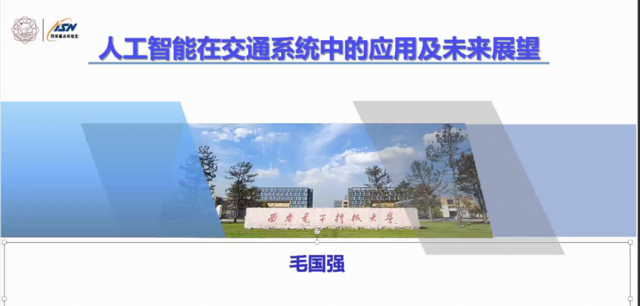
Prof. Mao explained the application of artificial intelligence in the field of transportation. At present, the global traffic problem is becoming increasingly serious. The annual economic loss caused by road traffic accidents worldwide is as high as 500 billion US dollars. How traffic accidents are formed is a complex system. We can’t have no overall plan for a fundamental transformation.
Prof. Mao mentioned that more and more sensors in the traffic system are using artificial intelligence technology, showed the digital twin system and perception system, and further described the traffic modeling, analysis and prediction. Through AI to model and analyze the correlation between the road network and traffic flow, Prof. Mao proposed a new method to control the traffic congestion after analyzing the traffic congestion.
The future direction faces some challenges. First of all, transportation is a very complex system. However, the previous studies lack a specific solution (the professional targeted analysis and the systematic sorting of application scenarios) to solve all problems. Secondly, current studies try to solve all problems with artificial intelligence and ignore the integration with “traditional” solutions, which leads to a limited performance in competition with simple methods. Finally, current artificial intelligence algorithms rely on a large amount of data for training, lack the active learning ability like humans, and cannot handle unprecedented scenarios.
Some prospects for the future development direction: 1. In-depth research on industry needs and closer integration with industry solutions; 2. Clear positioning and integration with various “traditional” methods; 3. Breakthroughs in basic disciplines are required, especially active learning ability.
Prof. Yong Shi (Fellow of the World Academy of Sciences (TWAS); Academician of the International Eurasian Academy of Sciences (IEAS); Director of the Research Center on Fictitious Economy and Data Science, Chinese Academy of Sciences; Director of Key Laboratory of Big Data Mining and Knowledge Management, Chinese Academy of Sciences; Professor with the Chinese Academy of Sciences) shared the keynote report on “The Development and Future of the Digital Economy”.
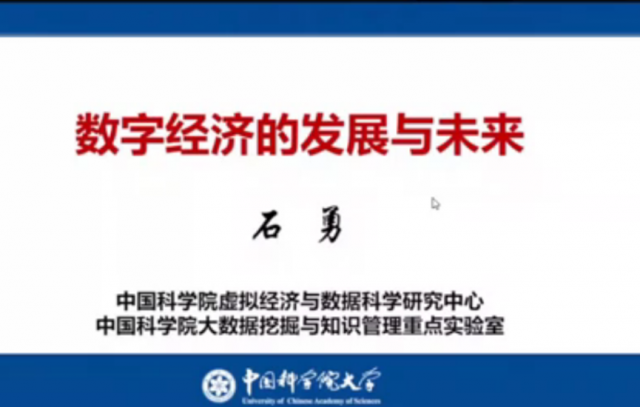
Prof. Shi first explained the basic issues of the digital economy. Big data is data with many sources, various types, large and complex, and potential value, but it is difficult to process and analyze in the expected time. Big data is a new strategic resource in the digital age, an important factor driving innovation, and is changing the production and lifestyle of human beings.
Big data analysis includes three basic principles: decision-making process, machine learning principle, and intelligent knowledge management; at present, data mining has the relationship between unstructured data structure, data complexity and uncertainty, data heterogeneity and decision heterogeneity challenge.
The current development of the international digital economy has gone from a period of technological preparation to a period of rapid prosperity to the current era of big data and artificial intelligence. At present, everyone pays more attention to the acquisition and usage of data, the experience of international digital development, and the digital construction guided by policies for building a digital government, developing basic telecommunication facilities, and promoting digital technology innovation. The development of the international digital economy is facing challenges such as population distribution, budget, data regulation and openness, cross-departmental collaboration, and privacy security; There are also some leading points in the international digital economy, such as the first guidance of laws and policies, innovation-driven enterprise development, and perfect market form.
The achievements of China in the digital economy during the 13th Five-Year Plan period include the continuous expansion of the scale of digital industrialization, the accelerated pace of industrial digital transformation, the continuous emergence of new business formats and new models, the innovative development of the digital economy, the integration and sharing of government information systems, and the improvement of people's livelihoods through digital services, including online education, online office, online shopping and contactless delivery services.
Furthermore, Chinese digital economy also faces many challenges, such as the economy is becoming big but not strong, the bottleneck existed needs to be broken through (mainly the operating system), and the international voice of Chinese digital economy needs to be improvedby actively participating in international organizations related to the digital economy to increase our voice.
At the end of the report, Prof. Shi also put forward suggestions and reflections. He personally put forward 6 suggestions to continue the enhancement of data openness and data protection, continue the promotion of big data vocational skills training, continue the policy support of the “bottlenecks”, accelerate the establishment of “one card, one QR” people’s livelihood service system, accelerate the constructure of a credit reporting system for the whole society, and actively strive for the right to speak internationally.
Prof. Fuchun Sun (Vice Chairman of Chinese Association for Artificial Intelligence (CAAI); IEEE Fellow; CAAI Fellow; Professor in the Department of Computer Science and Technology, Tsinghua University; Executive Deputy Director of the State Key Laboratory of Intelligent Technology and Systems, Tsinghua University) adopted the report theme of “Research and Progress in Cross-modal Learning”.
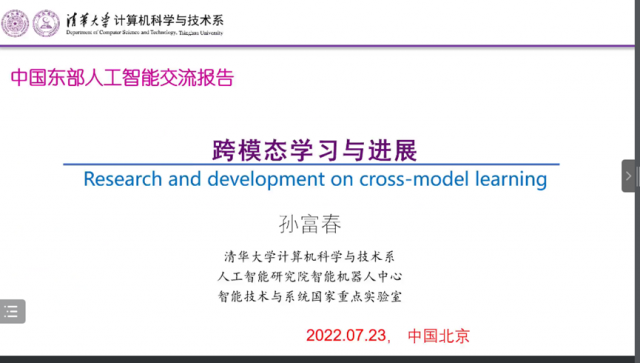
Prof. Sun utilized the example of human learning (grasping and manipulating objects, walking, reading and writing, and speaking the signified objects) to demonstrate cross-model learning which integrates the daily behaviors (vision, auditory, body somatosensory, or other perception) to increase the learning effect of another sense. In fact, most of the skills people acquire are cross-modal; infants' brains greatly depend on the interaction of different senses.
Subsequently, Prof. Sun analyzed the relevant research background. With the improvement of computing power and development of network structure, deep learning has achieved excellent performance in single-modal issues. In the past two years, more achievements were obtained by studies and papers on cross-modal and multi-modal learning. The report demonstrated the definition of modality, which refers to how things happen or exist. To further explain, modality refers to a certain type of information or the identification of that information, such as spoken words, text, images and videos, sound and music, etc. Multimodal research has gone through four eras: 1. the behavior era (1970-1980), 2. the computing era (1980-2000), 3. the interaction era (2000-2020), and 4. the deep learning era (2010-now).
the report describes the current core issues and research methods, including multimodal representation, multimodal alignment, cross-modal translation, and multimodal fusion. and multimodal collaborative learning, etc., and represents the current research achievements and many examples of Prof. Sun and his team.
Prof. Yuanyan Tang (IEEE Fellow; IAPR Fellow; Emeritus Chair Professor at Department of Computer and Information Science, Faculty of Science and Technology, University of Macau; Honorary Professor, Department of Computer Science, Hong Kong Baptist University) reported the theme of “Miniaturization of Machine Learning–One Direction of the Next Round of Artificial Intelligence Technology”.

Prof. Tang mentioned that artificial intelligence (AI) is accelerating from the “cloud” to the “edge” and into the smaller IoT devices. The machine learning process is implemented on the microprocessors on the terminal and edge side, called “mini-machine learning”, or TinyML. TinyML refers to methods, tools, and techniques for engineers to implement machine learning on devices in the milliwatt power (mW) range. As the intersection of machine learning and embedded IoT devices, TinyML is an emerging engineering discipline with the potential to revolutionize many industries. Finally, Prof. Tang introduced the latest research progress of micro-machine learning.
Prof. Guoying Zhao (Member of Finnish Academy of Science and Letters; IEEE Fellow; IAPR Fellow; Full Professor with the Center for Machine Vision and Signal Analysis, University of Oulu; Academy Professor with the Academy of Finland) gave a report on the theme of Vision based emotion AI.

Prof. Zhao explained macro-expressions, micro-expressions and subconscious body movements from shallow to deep, and deepened everyone’s understanding of facial expression recognition, micro-expression analysis, and emotional gesture recognition through animations and pictures. , video remote heart rate recognition and other technologies.
Finally, Prof. Zhao outlines some challenges and future research trends in this field. Among them, Prof. Zhao proposed that visual clues may not be able to collect information of a certain modality due to problems such as the collection environment or collection equipment and how to carry out multi-modal information in the absence of modalities. Emotions play an important role in human interactions and have become one of the focuses of future AI research. Applications include human-computer interaction, emotional chat, mental health and medicine, online learning, user or customer analytics, and others.
Prof Xiaobo Qu (Member of Academia Europaea; CJ Chair Professor with the School of Vehicle and Mobility, Tsinghua University) have a talk on the topic of “From intelligent transportation to intelligent travel”.
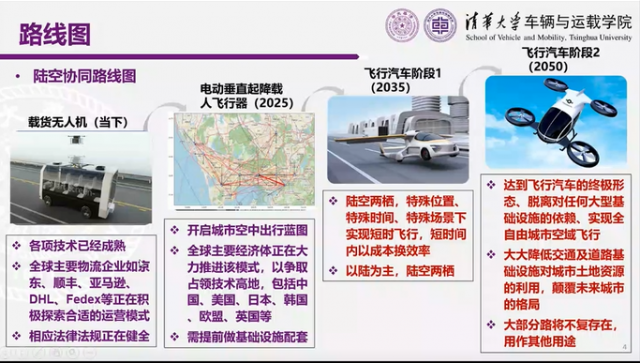
Prof. Qu pointed out that urbanization and three-dimensional transportation are inevitable. Interpret the research method of improving the traffic efficiency of intelligent vehicles through top-level design at the city and system levels, and introduce the team's forward-looking ideas in building an “energy cloud system” and a “three-dimensional transportation network” in detail. He said that building a “smart travel” system needs to focus on the future and coordinate innovation in the interdisciplinarity and called on universities, enterprises, and governments to work closely together in the deep integration of “production-learning-research-application”.
The summit was chaired by Prof. Jungang Xu (Director of the Cloud Computing and Intelligent Information Processing Laboratory of the University of Chinese Academy of Sciences and the Professor of the School of Computer Science, University of Chinese Academy of Sciences).